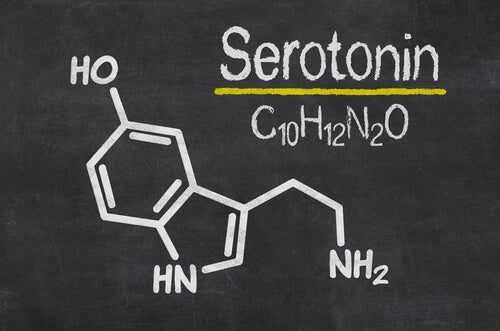Characteristics and Function of the Raphe Nuclei

The brain is the most-studied organ. However, it’s still a mystery. Some of its components are well known but others, such as the raphe nuclei of the brainstem, aren’t as much. The neurotransmitter they produce, serotonin, is almost part of the common vocabulary these days. Its importance for vital functions is invaluable.
In neurological terms, a nucleus is an accumulation of neuronal bodies, more or less delimited. They process a specific type of information or perform one or more specific functions thanks to their computational capacity. In fact, thanks to the nuclei, the brain and the rest of the nervous structures divide their functions and optimize them.
Researchers identified the raphe nuclei in the early stages of the study of the nervous system. However, they first identified serotonin in the digestive tract.
“Biology gives you a brain. Life turns it into a mind.”
-Jeffrey Eugenides-

Where are the raphe nuclei located?
The term “raphe”, in regard to anatomical location, refers to a line or indentation separating two symmetrical parts of the body. Researchers chose it to designate these nuclei. This is because of their arrangement around the midline of the brainstem, located between the brain and the spinal cord.
These are components of the so-called reticulate formation from a functional standpoint. It includes many other structures distributed throughout the salience network (SN) and plays a fundamental role in cortical activation and wakefulness.
Furthermore, the raphe nuclei are distributed at almost all levels of the brainstem, from the spinal cord to the midbrain. In addition, their arrangement happens in pairs of six nuclei approximately equidistant from each other. This may vary, though.
Definition and function of the raphe nuclei
The raphe nuclei are the primary location, of many more, from which the brain releases the serotonin it synthesizes. Thus, after production, this substance projects throughout practically the entire central nervous system.
Despite the type of neurotransmitter they produce, these nuclei are made of other cell types. In fact, serotonergic cells vary, in proportion, between 20 and 80 percent of the total cellular composition of the nucleus depending on which raphe nucleus is active.
Therefore, neurons that use other types of neurotransmitters as the primary substance of communication are also part of the cellular network that together comprise these nuclei.
Moreover, the raphe nuclei usually divide into two groups as a whole:
- Rostral, made of groups of nuclei located near the upper part of the brainstem.
- Caudal, their nuclei are closer to the lower region of the brainstem.
The nuclei of the rostral group contain up to 85 percent of the total serotonergic neurons in the brain. In addition, this group includes the following nuclei: caudal linear nucleus, dorsal raphe nucleus, and median raphe nucleus. Of these, the latter is the most abundant population of serotonin-producing cells in the entire salience network.
The caudal group, which involves a smaller grouping of serotonergic neurons, consists of raphe nucleus magnus, obscurus, and pallidus. The latter is the smallest of all the raphe nuclei.
The nervous functions attributable in origin to the raphe nuclei are many and complex. This is because there are many neuronal projections that start from them and extend throughout the salience network.
Brain with lateral vision
There are several particular functions, scientifically proven, whose origin can be tracked down to the raphe nuclei. This knowledge isn’t complete yet, though. The serotonergic ones are by far the ones that researchers study the most in relation to human behavior, among all the neuronal types in these nuclei.
The functions of nerve nuclei are:
- Serotonergic neurons traveling from the dorsal raphe nucleus to other nuclei in the brainstem play a relevant role in the regulation of sleep-wake cycles. These neurons, at times of alertness, show a high degree of activity. However, they’re generally inactive during the REM phase of sleep.
- Circadian rhythms are also due to the connection that the suprachiasmatic nucleus establishes with the anterior nucleus and with the median raphe nucleus.
- The nucleus and magnus have to do with the natural pain inhibition processes. The projections from these nuclei partially inhibit the spinal cord circuits responsible for transmitting pain signals.
- Serotonin, which acts in various parts of the organism and the salience network has a strong link, either directly or indirectly, with emotional states and mood. In fact, its participation in the regulation of these seems to be fundamental. This neurotransmitter is also related to aggressive behavior.
Serotonin is important for a large number of relevant mental functions. However, these nuclei are also important. This is because they’re the main synthesizers of this neurotransmitter in the nervous system.
This text is provided for informational purposes only and does not replace consultation with a professional. If in doubt, consult your specialist.








